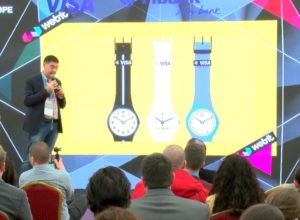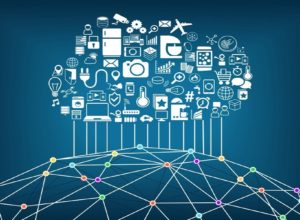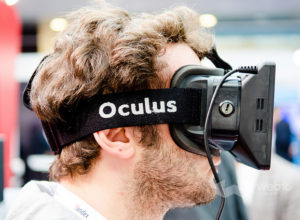Tag: Wearable Devices
The transforming world of payments
Visa is not the first credit card!
Maybe it’s no news for you, but for the majority of the audience of the Red Stage at Webit Festival, it certainly was. The one who made that revelation is the General Manager of Visa for Israel, Mr. Oded Salomy. He had a keynote at last year’s edition on enabling the transforming world of payments. Visa is one of the names that probably need no introduction. “Visa” has become a nickname for our payment cards. So much, that people tend to there’s much more behind it than just a plastic for payments. Payments is such a vast area that it’s quite unpredictable what the future will bring. We never know what’s going to impact payments and the booming fintech industry. Everyday payments, business to business payments, business to customer payments and reverse.. Machines paying other machines rather than humans, biometrics being used in order to identify people by their biological characteristics.. All the way up to crypto currencies and tokens. New services, easier to work with and keeping a proper security level are needed by this ever evolving system. Numerous startups have been trying to be the next “big thing” that will shake the world of payments as the price of Bitcoin did some time ago.In the Internet of Things space things have been connecting to Fintech too
Wearables such as rings, bracelets, wrist-watches and keychains are becoming more than just accessories - there are already ones out in sale that can allow us to pay on the move. Another category that’s being impacted is the connected cars. With just an Internet connection we can pay for grocery, for gas, parking, insurance while going to work or some more without the need to get out of the vehicle. And last but not least, check the Webit.Festival website for upcoming speakers and our ticket options.IoE makes us dream of a more connected tomorrow
We are living in the time of the Fourth Industrial Revolution - a process that unites biological, digital and physical spheres. And perhaps the most important condition for unfolding of this process is the coming age of Internet of Everything (IoE).
According to most experts, it will bring an enormous shift on our way of living, solving problems and creating value for business. In the near future our cars, houses, fridges, stoves, light bulbs, clothes and visual devices will all be interconnected.
This has the potential to create new capabilities, richer experiences and unprecedented economic opportunity for businesses, countries and individuals.
A Business Insider analysis calculates that by 2020 there will be around 34 billion devices connected to internet worldwide, compared to 10 billion in 2015. Internet of Things (IoT) devices will account for 24 billion, while traditional computing devices as smartphones and tablets will be around 10 billion.
Over the next five years the market for IoT solutions will reach nearly $6 trillion. Business is looking like the top customer of this kind of products because of the perspective for lowering of operation costs, increased productivity and expanding to new markets.
By year 2020 more than 5 billion people will be connected to the web. This is nearly seven times more than their number in 2000. The new internet users will come mainly from Africa and Asia and their connection will be mobile. This creates entirely new economic reality, which is already happening.
Just yesterday the idea of smart homes was interesting mostly for geeks and wealthy executives from the tech industry. But platforms like Amazon’s Alexa are soon going to make this concept affordable for nearly everyone in the developed world.
With the coming of more people online, companies like Google are trying to make their services more accessible with smaller apps for budget devices and offline support.
Today the tech giant announced that its Google search app for Android will save our queries while we are offline and deliver the results when our internet connection is established again.
As Android is the most used operating system in developing economies where the internet quality is low this new feature will be pretty helpful for the millions of new users. Soon the company is going to apply it for iOS too.
Meanwhile, Google is working with LG on producing the first Android Wear 2.0 devices - the LG Watch Sport and LG Watch Style. The smartwatches will be revealed on February 9. Both devices have options for Wi-Fi and Bluetooth connectivity, while the sport model features cellular connectivity with 3G and LTE data, as well as GPS.
As for now the expansion of wearables benefits mostly retailers and technological businesses, but the new features in these devices have the potential to improve our day-to-day activities and quality of life.
IoE will make us more self aware in every life aspect of life, from eating habits and sport to management of our home and finances.
You can learn more about the rise of mobile tech, sharing of information and connected devices during Webit.Festival 2017. During the two-day agenda of the festival in Sofia you can listen to top level speakers from all over the world, who will share their experience on topics, such as Marketing & Innovation, Big Data & Cloud, IoE, Digital Transformation, FinTech & Blockchain, Security & Privacy, Health & Wellbeing and Mobility.
Can Wearable Devices change our life?
Wearable devices are all around and wearable technology is changing our life styles by allowing us to track and interact with the surrounding world in new ways. They are changing the perception of the ways we see, hear and interact with the world around us.
According to ABI Research, about 90 million wearable devices will be sold in 2014 and demand will be higher in 2015. Most wearables are related to health and fitness but the future will see them in other fields.
What are wearable devices?
According to Wikipedia “wearable technology“, “wearable devices“, and “wearables” all refer to electronic technologies or computers that are incorporated into items of clothing and accessories which can comfortably be worn on the body.
Wearable devices, similar to mobile phones and laptop computers can perform the same computing tasks in some cases outperforming them. They have embedded sensors and can transmit information. Wearable technology tends to be more sophisticated than mobile devices providing sensory and scanning features not typically seen in mobile and laptop devices, such as biofeedback and tracking of physiological functions.
Why do we use them?
They are all around us watches, glasses, contact lenses, e-textiles and smart fabrics, headbands, jewelry such as rings, bracelets, and earrings. Most wearables on the market today are fitness and healthcare monitors.
Worn on our head like the Google Glass and Oculus Rift, on our wrist like the Pebble steel, Fitbit Flex or Nike + Fuelband, Moto 360, on our chest like the Uber Armour Chest strap or Polar Wearlink and Transmitter, on our ankle like the Adidas F50 Aadizero TRX Cleats. They are being intercorporated in our clothes. They can be attached to a baby like the Sproutling Baby monitor that senses, learns and predicts a baby's sleep habits.
What are the future trends for wearable devices?
Wearables still are a technology for early adopters. They are not perfect and there are still lots of questions to be resolved. Privacy, safety, design and customer adoption, just to mention a few. However, the future of wearable devices looks promising. Juniper research predicted the market to jump from its current $2 billion value to $19 billion by 2018.
An in the world of IoT giants like Google, Microsoft, Apple, Intel, IBM are working on new and improved solutions to help wearables. Apple is set to release its new and exciting iWatch expected to be a game changer. Intel is working on standards of interoperability. We are seeing better integration and new applications developed for the wearable devices. The startup community is also working on new devices and solutions.
Join us at the blue track of the Global Webit Congress to learn more on these promising new technologies.
Get your early bird ticket now.


